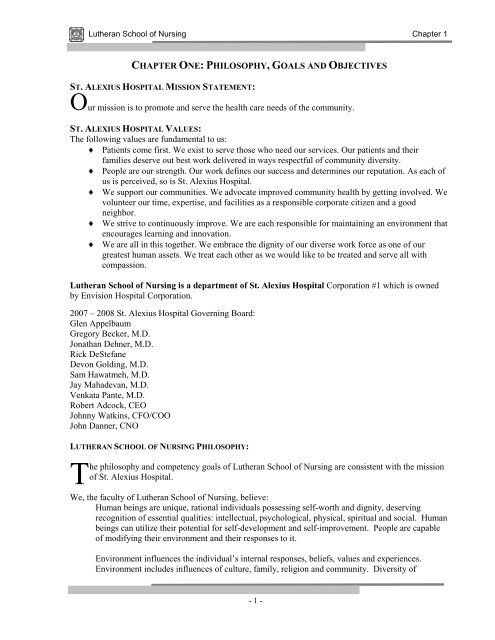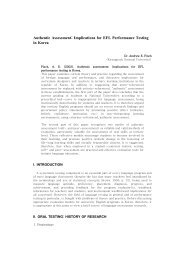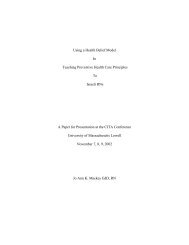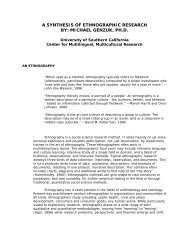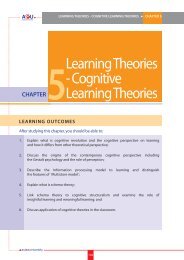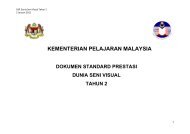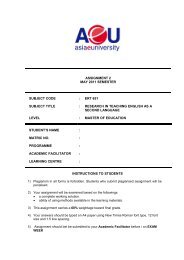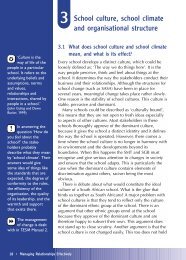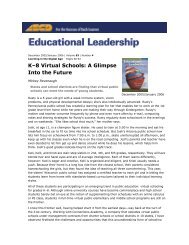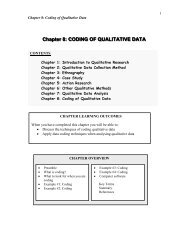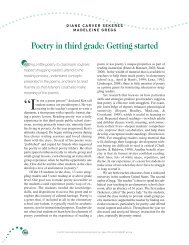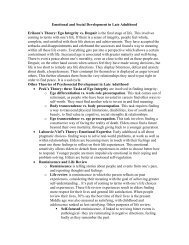CHAPTER ONE: PHILOSOPHY, GOALS AND OBJECTIVES
CHAPTER ONE: PHILOSOPHY, GOALS AND OBJECTIVES
CHAPTER ONE: PHILOSOPHY, GOALS AND OBJECTIVES
Create successful ePaper yourself
Turn your PDF publications into a flip-book with our unique Google optimized e-Paper software.
Lutheran School of Nursing Chapter 1environment and the individual is respected at all times. Health care professionals recognize thegrowing diversity of society and the need to provide culturally sensitive care. Health careprofessionals must also recognize their role to assess and analyze a community in order to relate avariety of contexts ranging from individual patient encounters to the management of complexsystems. Community health involves the ability to work with others to integrate a range ofservices and activities that promote, protect, and improve health.Health is a dynamic state of wellness. Health practices prevention and wellness with an emphasison primary and secondary preventive strategies. Promoting healthy lifestyles enhances health.Promotion and prevention involves patients, families, and communities in participation ofdecisions regarding their personal health, and in evaluating its quality and accessibility. Healthcare professionals have a responsibility to participate as “community partners” and advocatepublic policy for promotion and protection of the health of society.Nursing is a complex, interactive profession that is an art and a science. Nursing provides specificscientific, evidence based support and assistance to individuals and/or families, managinginformation and technology, while also assuming a personal code of ethics and socialresponsibility. Nurses must have up-to-date clinical skills and abilities as critical thinkers andproblem solvers. As primary care givers, nurses must be prepared to function in new health caresettings and with multiple interdisciplinary team members designed to provide optimallycoordinated care. Today’s nurse strives to insure cost-effective care balanced with appropriatecare and quality of services and health outcomes.Education is a process resulting in the learner’s cumulative, progressive acquisition of knowledge,skills, competencies, values, attitudes and outcomes. It requires an environment of active,creative, and innovative participation between teacher and learner. Education seeks to beproactive in anticipating changes in health care and responding appropriately for preparation of thegraduate nurse. Learning is a self-directed, life-long learning process, maintaining anddemonstrating competencies throughout one’s practice life.The faculty of the school is responsible for integrating the philosophy into the academic program.Responsibility to the student focuses on facilitating effective adult learning by providing anappropriate learning environment that promotes the acquisition of knowledge, skills,competencies, values, attitudes, and outcomes essential to the development of the professionalentry-level nurse.Faculty has an obligation to perpetuate effective adult learning through scholarship. The diplomaprogram of nursing recognizes that there are diverse ways of achieving scholarship through thecollective abilities, creativity, and expertise of its faculty. The forms of scholarship are recognizedand achieved through the shared philosophy and definition based in part from Boyer’s ScholarshipReconsidered: Priorities of the Professorate (1990). These forms of scholarship includediscovery, integration, application, and teaching.Discovery is purely investigative, in search of new information. Faculty believes that discoveryscholarship in a diploma program can be fulfilled through formal research, publication, facultystudies and/or projects, continuing education, and professional memberships.Integration occurs when scholars put isolated facts into perspective. Faculty in the diplomaprogram believes that interdisciplinary collaboration of professionals offers the unique opportunity- 2 -
Lutheran School of Nursing Chapter 1CURRICULUM DESIGNCURRICULUM PLANLEVELPlanned sequence of courses set up to accomplish thepurpose of the education program.A schematic representation of the curriculum design.Refers to predetermined intervals at which points astudent demonstrates changes in knowledge andbehaviors as a result of related learning experiences. Inour school, the two levels are identified as follows:LEVEL I: Prepares the student to provide basic nursingcare to clients based on biopsychosocial principles;prepares the student to individualize nursing care to meetaltered health needs of adult medical-surgical clients.LEVEL II: Prepares the student to provide nursing care toclients, groups of clients and families with psychiatric,obstetric, pediatric and advanced medical surgicaldisorders. The final role transition course gives thestudent opportunities for making the transition tograduate nurse.COURSECOURSE <strong>OBJECTIVES</strong>COURSE OUTLINEUNITUNIT <strong>OBJECTIVES</strong>THEORYCLINICAL LABORATORYCLASSROOM LABORATORYA course provides organized subject matter and relatedactivities and experiences planned to achieve objectives.A course is offered within a major division of time in thecurriculum plan.Indicate the behaviors the student should demonstrate atthe completion of the course. They give direction tocourse content, learning activities and course evaluation.Lists the unit objectives, content and major learningexperiences (laboratory and theory) of a particular course.A unit is a division of a course focusing on a major bodyof knowledge and skills that contributes to the course as awhole.Indicate behaviors based on theory instructions that areexpected of the student at the completion of the unit.Refers to a body of material presenting a concise,systematic view of subject matter. Theory content issubject to written examination.Planned learning experiences in which the student canapply knowledge to the care of clients in a clinical setting.Planned learning experiences in which the student canpractice and/or apply nursing concepts, theories, skills,- 6 -
Lutheran School of Nursing Chapter 1TERMS RELATED TO THEORY <strong>AND</strong> LABORATORY COMP<strong>ONE</strong>NTS OF CURRICULUM(Terms necessary for students to use during the program.)ACTIVITIES OF DAILY LIVINGANALYZECLASSROOM LABORATORYCLINICAL COMPETENCYCLINICAL LABORATORYCOMMUNICATION ABILITIESCOMMUNITYCOMPARECORRELATECREATECRITICAL THINKINGDEMONSTRATEDESCRIBEDEVELOPDEVELOPMENTAL SELF CAREREQUISITESActivities performed by the client each day to care for his/her ownneeds, e.g. eating, bathing.To examine critically, pulling together constituent parts of aproblem/situation.Planned simulated learning experiences in which a student canpractice nursing skills.Specific behaviors necessary for the practice of a particular areaof nursing. The ability to demonstrate these behaviors has beendetermined by the faculty to be essential for safe practice of thecompletion of the clinical objectives.Planned learning experiences in which the student can applyknowledge to the care of clients in a hospital or communitysetting.Process which measures the development and progressive use ofbasic communication, therapeutic communication and effectivecommunication. This includes abilities in written, verbal andnonverbal communications, group process, informationtechnology and/or media production.A group of individuals and/or families who share a commongeographic area or environment and have an interest in theinstitutions that governs and regulate their way of life.To determine similarity/resemblance of information.To show a relationship.To formulate from collected data.A process that challenges an individual/student to interpret andevaluate information, apply knowledge and experience, makeinferences, form conclusions, apply reason, logic and standards inmaking sound nursing judgments and decisions.To show by action.To give an account of information.To bring to a more advanced and/or individualized state.Factors associated with self-care which are related to physical orsocial development, e.g., pregnancy, childhood, aging, education.- 8 -
Lutheran School of Nursing Chapter 1DIFFERENTIATEDISCUSSEVALUATEEXAMINEEXPLAINFAMILYHEALTH TEACHINGIDENTIFYIMPLEMENTINTEGRATEINTERACTNORTH AMERICAN NURSINGDIAGNOSIS ASSOCIATION(N<strong>AND</strong>A)NURSING CARENURSING DIAGNOSISNURSING PROCESSPERFORMPRACTICUMTo show a difference in.To present the information in detail.To examine and judge the value of information.To look over, inspect visually or by use of other senses; inwritten work, to determine accuracy or quality.To give a cause or reason for the information.A unit of interacting persons whose central objective is to createand/or maintain a common culture and promote the physicalmental and social development of its members.Transmission of information to the client to foster and/ormaintain the activities of daily living.To list or state the information.To carry out the task.To incorporate small segments of knowledge into a larger unit.To exchange information between individuals.An organization responsible for developing taxonomy ofconditions from which the RN chooses actual or potentialalterations in health status as the basis for planning andevaluating nursing interventions.The art and skills necessary to assist or encourage the client toaccomplish the activities of daily living.Statement of an actual or potential altered health status of aclient which is derived from nursing assessment and whichrequires interventions from the domain of nursing.Five step process to establish a data base, identify the client’shealth care needs, determine priorities of care, goals, andexpected outcomes, establish a care plan, in order to providenursing interventions to meet client needs and determine theeffectiveness of nursing care in achieving client goals.To carry out patterns and procedures based on establishedprinciples.First clinical laboratory experience focused on meeting specificcare needs of clients.- 9 -
Lutheran School of Nursing Chapter 1PRIORITIZESELF-CARE AGENCYSELF-CARE DEFICIT THEORYSYNTHESISUNIVERSAL SELF-CARE REQUISITESTo arrange in descending order of importance.Abilities and limitations of the individual (self-care agent) tocarry out therapeutic self-care demands to meet universal selfcarerequisites.People can benefit from nursing because they are subject tohealth-related or health-derived limitations that render themincapable of continuous self-care. This theory constitutes thecore of Orem’s general comprehensive theory of nursing.To propose, plan, produce, design, modify, synthesize,formulate, develop; take previously learned information andform new patterns or wholes.Factors common to all human beings throughout the life span;e.g., air, water, food, elimination, rest and activity, solitude andsocial, protection from hazards, normalcy.NON-DISCRIMINATION STATEMENTLutheran School of Nursing does not discriminate on the basis of race, color, religion, age, sex, maritalstatus, national or ethnic origin, or disability in the administration of its educational policies,scholarship and loan program, athletic, or other school administered programs.If individuals believe that they have been subjected to such discrimination, they should contact theDirector of Human Resources, who is the Title IX and Section 504 Coordinator for St. Alexius Hospital.EDUCATIONAL POLICYWhen an applicant is admitted to the Lutheran School of Nursing, he/she is subject to all policies andprocedures of the school. Admission to the school carries no assurance of promotion, graduation, orawarding of a diploma. Continuation as a student, promotion, and eventual graduation are dependent onthe fulfillment of all academic requirements and compliance with all policies and procedures of theschool. Failure to comply with these requirements may result adverse consequences, up to and includingdismissal. If the student is dismissed, no assurance is given that he/she will be readmitted. Due process isafforded to any student who feels that a policy or procedure has been unfairly administered, as explainedin Chapter 7 of the Student Handbook.CHANGES TO POLICIES <strong>AND</strong> PROCEDURESAll policies, procedures, requirements, and costs shown in this handbook are subject to change withoutprior notification. Students should check both their individual mailboxes and the official bulletin boardsregularly (see <strong>CHAPTER</strong> 3 on COMMUNICATIONS) for the most accurate and up to date information. Allreasonable actions will be taken to inform students of changes to policies, procedures, and costs prior tothe actual effective change.- 10 -


